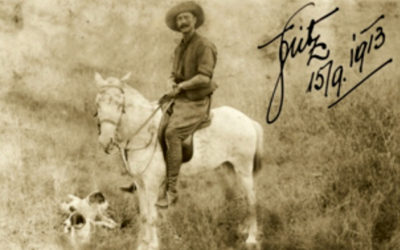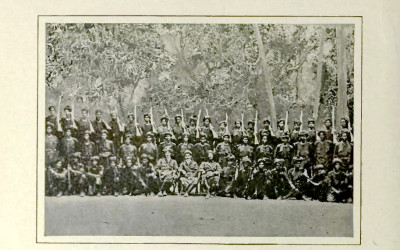More Stories from East Africa's past for you to enjoy
Where Antelope Roam: by Jon Arensen
New From Old Africa books! Where Antelope Roam: And Other Stories Out of Africa by Jon Arensen The short stories in this book are all connected to Jon Arensen's experiences in East Africa. They are deeply personal and are narrated in the first person. As in any good...
Brian Havelock Potts
What caused young men to join the exodus from Britain to East Africa in 1910-1912? Let us take one example and look at his memoir. Brian Havelock Potts, born in Brixton on 30 March 1891 as a fourth child and only son, came from a middle-class family. His father William Potts was a journalist (a parliamentary reporter in 1891) at the Morning Standard and was made redundant when Brian was 15. Brian became an office boy in a London stockbroker’s. There a friend told him his brother was growing coffee in Nairobi. This prompted the young Brian to visit Rowland Ward’s (the taxidermist in Piccadilly), and next door stood the safari outfitters Newland Tarlton…
Violet Donkin and Fritz Schindler – Matron of Scott Sanatorium Grieves After Fiancee Dies Following Lion Attack
For the last two months I have been talking about the founding of the Scott Sanatorium, and the part Violet Donkin played in this. However, a year after the facility opened, she departed for England. Why? A scrutiny of the surviving manuscripts gives us a clue. We learn from The Leader of 24 January 1914 that Violet had recently left ‘upon medical advice.’ Then, in an obscure journal of Brian Havelock Potts held in the Bodleian Library, Oxford, we find that Potts served in the army after the outbreak of the First World War, contracted amoebic dysentery, and was taken to the Scott Sanatorium…
On Call in Africa – book review
On Call in Africa in War and Peace, 1910-1932 by Norman Parsons Jewell Norman Jewell’s memoir gives us the best eyewitness account of medical conditions among the troops fighting in East Africa that has been published so far. It is a riveting story of...
Violet Donkin and the Scott Sanatorium
Violet Donkin and the Scott Sanatorium Last month we read about the establishment of the Scott Sanatorium outside Nairobi under the leadership of the nurse and midwife (Frances) Violet Donkin. Who was she? I mentioned her in my blog of 9 May 2012, but gave few...
The Scott Sanatorium
The Scott Sanatorium In 1912 it was felt that there was a need for a sanatorium in Nairobi for white settlers, and the idea for the Scott Sanatorium took root. What was the origin of its name? It was named for the Rev. Henry Edwin Scott, LRCP and SE, a medical...
An Eccentric East African Hotelier
An Eccentric East African Hotelier If you crossed the Kenya border into Uganda in the 1940s you came across a rather dilapidated building with a faded tin roof, half a mile from the border, at Tororo. On a board it announced itself as a bar: ‘Prop.: H.H....
Sneak Preview: Horse Racing in Kenya
Old Africa has been working for over two years on a project covering over 100 years of horse racing in Kenya. We've just completed the rough edit of the full book and are moving into the stage for final editing and photo selection. I think we can use about 300 of the...
First European Schools in Kenya
The First European Schools in Kenya On reaching Nairobi in 1900 the Uganda Railway set up its own school there for the children of its white workers, in a corrugated iron shed near Nairobi station. The first school for European children in Nairobi was set up by the...
The Kakamega Goldfields
The Kakamega Goldfields The recent interest in gold in the Kakamega district reminds us of the first gold rush in the region – in the early 1930s. In 1930 Kakamega township was an open space with a few Indian dukas, but in the middle of the decade it became a...
Home Guards Killed While Returning Escaped Prisoners
Solomon Njihia was the head chef for the Rift Valley Academy kitchen when I was a student there in the 1970s. I just heard he has passed away. Another link to Kenya's past has gone. About eight years ago I interviewed Solomon and he told me a story of how he and a...
Firebrand Editor of the Kenya Press: Harold George Robertson (‘Rab the Rhymer’)
Firebrand Editor of the Kenya Press: Harold George Robertson (‘Rab the Rhymer’) From the age of ten in the 1950s I was an avid daily reader of the Mombasa Times and loved its crossword. So I was very interested to come across some details of one of its former...
Wavell 100 Year Memorial Tour
Join Guerrillas of Tsavo author, James G Willson on Saturday 9th & Sunday 10th January 2016 when he will lead a tour Commemorating the centenary of the January 1916 Mkongani Battle, Kwale, where Major Arthur Wavell MC and 15 of his loyal Arab Rifles lost their...
Escape from Singapore
Escape from Singapore Our December-January edition of Old Africa magazine has a story by Barbara Dods. She tells about growing up in Nairobi while her father, Arthur James Scott Hutton was the architect overseeing the building of Kenya’s Government House (which later...
More About Vladimir Verbi
I’d like to return to the subject of Vladimir Verbi (see my blogs of February and December 2013), the missionary who shot his mother-in-law in the Taita Hills in 1941. To recap, Verbi was having trouble with his second wife, Lascelles, and forbade her going to a party in Voi. When she disobeyed, he angrily took his gun into the garden, because he was trying to deter crows from eating his strawberries…
Lady Sidney Farrar
My last blogs have been concerned with the role of European women in Kenya, particularly in World War 2. It has become clear that a leading role was played by Lady Sidney Farrar. Who was she? She was the daughter of the 7th Earl of Buckinghamshire, who boasted the names Sidney Carr Hobart-Hampden-Mercer-Henderson…
New from Old Africa books…The Sultan’s Spymaster
The Sultan’s Spymaster tells the story of Peera Dewjee, an Ismaili merchant who crossed from India to Zanzibar as a boy. Later he became Sultan Barghash’s barber and valet, where he became a confidant to the Sultan and a trusted advisor. Peera Dewjee acted behind the scenes during momentous events in the history of Zanzibar and East Africa – the closing of the slave markets and imperial expansion by Germany and Great Britain.
The Role of Kenya’s Settler Women in World War 2
As troops flocked into Kenya to defend the country from possible Italian invasion from Abyssinia (Ethiopia) in the north, so Kenya’s women rushed to help the war effort. Up-country towns such as Nanyuki became gorged with South African troops, and its hotel, the Sportsman’s Arms, rang with their favourite song, Sarie Marais. As the male farmers flocked to the recruitment offices, their womenfolk took over the running of the farms. Nearly 800 women were employed as owner-farmers, assistants, or acting on behalf of menfolk serving in the forces…
















